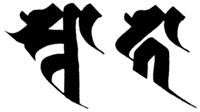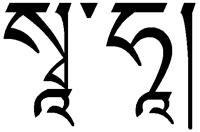svāhā is not really a seed-syllable, since it is two syllables, but in Buddhist mantras it does function in the same way as a seed-syllable. Monier-Williams says the etymology is probably su (good, well, whole, etc) + ah (to call, to say, to speak, etc); so that it would literally mean something like: "well spoken". Conze translates it as "all hail" and most other translators seem to follow him. However he admits that it is not a very satisfactory translation. He refers to svāhā as a term of blessing: "an ecstatic shout of joy, expressive of a feeling of complete release". [Conze, Buddhist Wisdom Books, p.128]
Svāhā is imported from Vedic ritual, where it was used when making oblations to the sacred fire. After each ladle of offering the priest exclaims svāhā! In the Yajur Veda there are long lists of phrases which have the name of a god in the dative form (meaning to or for the deity) followed by svāhā, e.g agnaye svāhā, somāya svāhā (Taittirīra Saṃhitā 7.1.14.1). These may be the precursors of Buddhist mantras.* Svāhā first shows up in Buddhist texts in the Dhāraṇīs which were interpolated into Mahāyana sūtras such as the White Lotus and Golden Light.
It becomes a standard ending for Buddhist mantras, and although Conze suggests that it indicates a feminine deity, this is clearly not the case.
Other bījas: a | āḥ | dhīḥ | hūṃ | hrīḥ | maiṃ | oṃ | tāṃ | traṃ | phaṭ |
Examples
 |
 |
 |
| svāhā Siddham |
svāhā Devanāgarī |
svāhā Tibetan - Uchen |
Notes
svāhā occurs at the end of the mantras for Śakyamuni, Maitreya, Bhaiṣajyarāja / The Medicine Buddha, Locanā, Māmakī, Paṇḍāravāsinī, Tārā, Ākāśadhātīśvarī, and in the Heart Sutra Mantra.
svā is a Conjunct consonant which combines sa and va with the long ā diacritic.
* the connection between Yajur Veda and Buddhist mantras was suggested to me by Maitiu O'Ceileachair.
